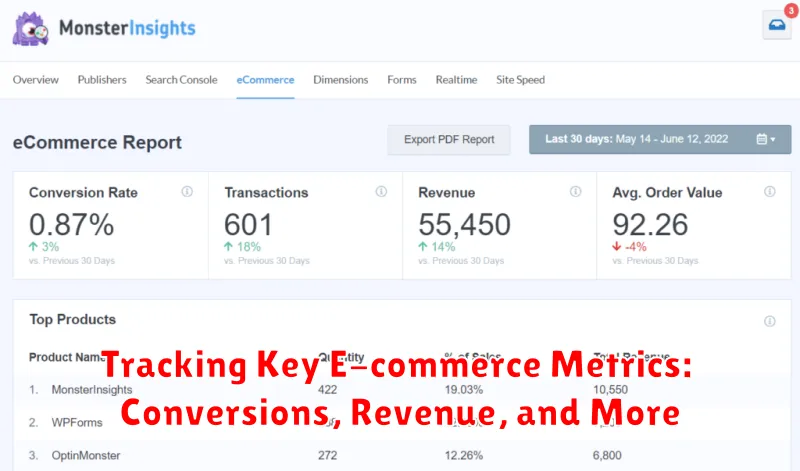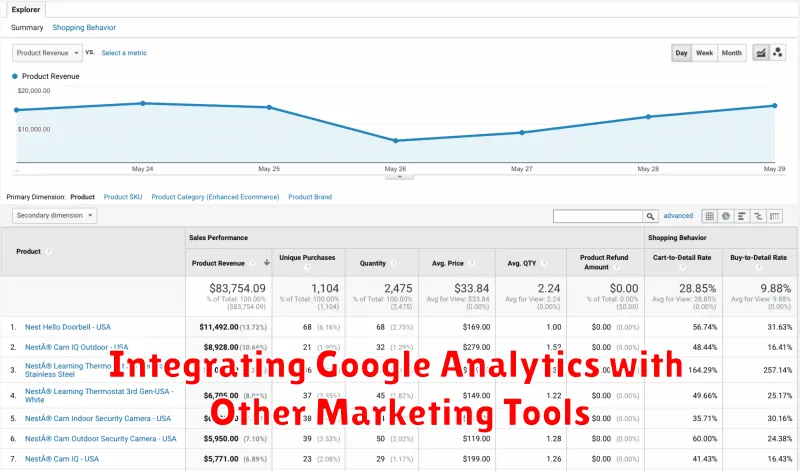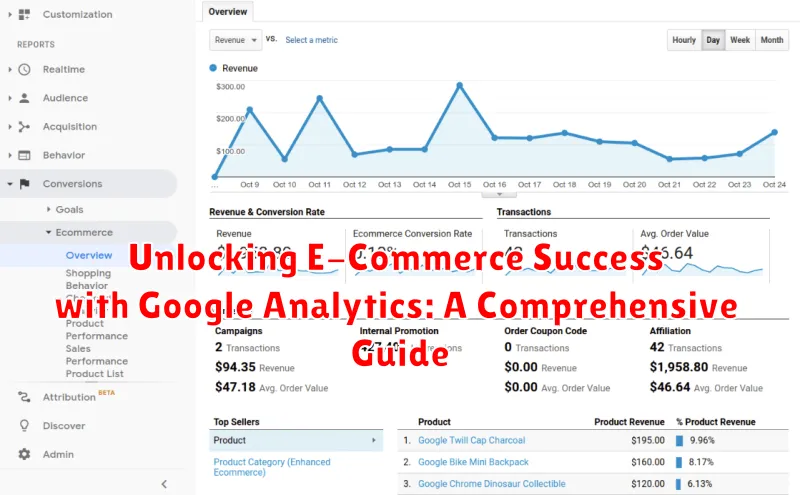In today’s fiercely competitive digital landscape, e-commerce success hinges on data-driven decisions. Understanding your customers, their behavior, and your website’s performance is paramount. This comprehensive guide will delve into how Google Analytics can be leveraged as a powerful tool to unlock the full potential of your e-commerce business. From tracking key metrics and identifying areas for improvement to optimizing conversions and maximizing ROI, Google Analytics provides the insights you need to thrive in the e-commerce world.
Whether you are a seasoned e-commerce entrepreneur or just starting your online journey, this guide offers a step-by-step approach to harnessing the power of Google Analytics. We will cover the essential features, configurations, and reporting techniques to transform raw data into actionable strategies. Learn how to track e-commerce transactions, analyze customer behavior, and ultimately, drive e-commerce growth with the help of this indispensable platform. Prepare to unlock the secrets to e-commerce success with Google Analytics.
Understanding the Power of Google Analytics for E-commerce
In the competitive landscape of online retail, data is king. Google Analytics empowers e-commerce businesses with the insights needed to thrive. It provides a comprehensive view of your online store’s performance, allowing you to understand customer behavior and optimize your strategies for increased profitability.
By tracking key metrics, you can identify what’s working and what needs improvement. This data-driven approach enables you to make informed decisions about marketing campaigns, product offerings, and website design. Understanding your audience is crucial for targeted advertising and personalized shopping experiences. Google Analytics provides valuable demographic data, interests, and even the devices customers use to access your store.
Ultimately, Google Analytics allows you to measure the effectiveness of your e-commerce efforts and make necessary adjustments to maximize your return on investment (ROI). It transforms raw data into actionable intelligence, enabling you to refine your strategies and achieve sustainable growth.
Setting Up Google Analytics for Your Online Store
Integrating Google Analytics with your e-commerce platform is the first step towards data-driven decision-making. This process involves creating a Google Analytics account and implementing the tracking code on your website.
Create a Google Analytics Account: If you don’t already have one, sign up for a free Google Analytics account. Provide the necessary information about your business and website.
Implement the Tracking Code: Once your account is set up, you’ll receive a unique tracking code. This code needs to be added to every page of your online store. The placement of the code typically involves inserting it within the <head> section of your website’s HTML.
E-commerce Tracking: For enhanced e-commerce tracking, enable Enhanced Ecommerce within your Google Analytics view. This feature provides detailed insights into customer behavior and purchasing patterns.
Platform-Specific Instructions: Refer to your e-commerce platform’s documentation for specific instructions on integrating Google Analytics. Many platforms offer streamlined integration options or plugins that simplify this process.
After completing these steps, Google Analytics will begin collecting data from your online store, allowing you to monitor its performance and make informed business decisions.
Tracking Key E-commerce Metrics: Conversions, Revenue, and More

Tracking key metrics is crucial for understanding your online store’s performance. Google Analytics provides valuable insights into conversions, revenue, and other essential data points. This allows you to measure the effectiveness of your marketing campaigns and identify areas for improvement.
Conversion tracking reveals how effectively your website turns visitors into paying customers. Monitor your conversion rate to understand which strategies are driving sales. Revenue tracking shows the total value of transactions generated through your e-commerce platform. Analyzing revenue data helps you identify your most profitable products and customer segments.
Beyond conversions and revenue, track average order value (AOV) to understand customer spending habits. A higher AOV can significantly impact your overall revenue. Also, monitor transactions per user to gauge customer engagement and identify opportunities for repeat purchases.
By closely monitoring these key e-commerce metrics in Google Analytics, you gain the data necessary to optimize your strategies and maximize your online store’s success.
Analyzing Customer Behavior: Traffic Sources, Demographics, and Interests
Understanding your customer base is crucial for effective e-commerce strategies. Google Analytics provides valuable insights into customer behavior, allowing you to tailor your marketing and optimize your online store for better results.
Traffic source analysis reveals where your customers are coming from. Are they finding you through organic search, social media, or paid advertising? Identifying the most effective channels allows you to focus your marketing efforts and budget allocation.
Demographic data like age, gender, and location helps you create targeted marketing campaigns. Understanding who your customers are enables you to personalize their experience and offer relevant products or promotions.
Analyzing customer interests, based on their browsing behavior on your site, provides further insights into their preferences. This information can guide product development, website design, and content creation to better cater to their needs and ultimately drive conversions.
Leveraging Google Analytics Reports to Make Data-Driven Decisions
Google Analytics provides a wealth of reports to inform strategic decision-making. By understanding these reports, you can optimize your e-commerce store for increased conversions and revenue.
The Acquisition reports reveal where your traffic originates, helping you identify high-performing channels and areas for improvement. For instance, if organic search drives significant traffic, investing in SEO can yield higher returns.
Behavior reports offer insight into how users interact with your website. Analyze bounce rates, page views, and average session duration to pinpoint areas of friction or high engagement. This data can inform website design changes and content optimization strategies.
Conversion reports, specifically the Ecommerce Overview, track crucial metrics like transactions, revenue, and conversion rates. Identify products with high conversion rates and those struggling to perform. This information can inform pricing adjustments, product placement, and promotional campaigns.
Regularly reviewing these reports and acting on the data provides a competitive advantage. Data-driven decisions replace guesswork, leading to more effective marketing campaigns and increased profitability.
Advanced Google Analytics Techniques for E-commerce Optimization
Leveraging advanced Google Analytics techniques can significantly enhance your e-commerce strategies. Segmentation allows for analyzing specific user groups, such as those who abandoned their carts or made repeat purchases. This data helps tailor marketing efforts and improve conversion rates.
Custom reports provide a granular view of key metrics, enabling data-driven decisions. By tracking specific product performance, marketing campaign effectiveness, or customer behavior, you can optimize your e-commerce efforts for maximum impact.
Enhanced Ecommerce tracking goes beyond basic transaction data, providing insights into the entire customer journey, from product views and add-to-carts to checkouts and refunds. This comprehensive data reveals opportunities for improvement at each stage of the sales funnel.
Integrating Google Analytics with Other Marketing Tools

Integrating Google Analytics with other marketing tools provides a holistic view of your e-commerce performance. This integration empowers you to make more informed decisions by centralizing your data and understanding the complete customer journey.
Key integrations include connecting Google Analytics with your CRM platform, email marketing software, and social media advertising platforms.
For instance, linking Google Analytics with your CRM allows you to analyze website behavior based on customer demographics and purchase history. This data helps identify high-value customers and tailor marketing campaigns more effectively.
Integrating with email marketing platforms helps track campaign performance and understand how email drives website traffic and conversions. This integration allows for optimized email targeting and personalized messaging.
Connecting Google Analytics with social media platforms provides insights into which social channels are most effective in driving traffic and sales. This information enables data-driven decisions on ad spend and content strategy.

